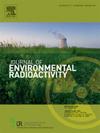影响氡气在水中溶解速率的因素。
IF 1.9
3区 环境科学与生态学
Q3 ENVIRONMENTAL SCIENCES
引用次数: 0
摘要
水中氡(222Rn)的测量广泛应用于各个学科,包括技术、医学、勘探和生态保护。要精确测量水中的氡,必须有标准的氡溶液。研究人员在开发标准氡溶液时,主要关注的是氡分布达到平衡后的水中氡浓度(RCW),而不是平衡前的氡溶解速率。这使得校准标准氡溶液的制备速度较慢,严重制约了标准装置的研发。本文旨在研究氡溶解速度与气态氡浓度和搅拌速度之间的相关性。通过单变量分析得出了四个结论。➀ 水中的氡浓度(RCW)随着氡溶解时间的延长而增加,最终达到平衡状态。➁ 气体氡浓度的增加与氡溶解速率的同步上升相关,而氡分布平衡所需的时间保持不变。当搅拌速度过高时,会导致 RCW 和氡溶解率大幅波动。因此,在使用这种方法制备氡溶液时,建议将氡溶解的持续时间调节为 30 分钟(搅拌速度为 380 弧度/分钟)和 10 分钟(搅拌速度为 480 弧度/分钟)。这样可以确保达到精确的浓度。在环境稳定的条件下,仅操纵气体氡浓度就足以调整 RCW。这些经验性发现为高效制备标准氡溶液和必要的仪器奠定了坚实的基础,而这些对于校准氡测量仪器并保证其精确性至关重要。本文章由计算机程序翻译,如有差异,请以英文原文为准。
Factors influencing the dissolution rate of radon gas in water
Measurements of radon (222Rn) in water are widely utilized across various disciplines, including technology, medicine, exploration, and ecological preservation. For accurate radon measurements in water, the availability of a standardized radon solution is essential. Researchers have predominantly concentrated on the radon concentration in water (RCW) once radon distribution equilibrium is achieved, rather than the rate of radon dissolution prior to equilibrium, in the development of standard radon solutions. This makes the preparation speed of the calibration standards radon solution slow, which seriously restricts the research and development of the standard device. The purpose of this paper is to investigate the correlation between the rate of radon dissolution and both the concentration of gaseous radon and the stirring speed. Four conclusions have been derived through univariate analysis. ➀ The radon concentration in water (RCW) increases with the duration of radon dissolution, eventually reaching a state of equilibrium. ➁ The increase in gas radon concentration correlates with a simultaneous rise in the rate of radon dissolution, while the time required for radon distribution equilibrium remains constant. ➂ The augmentation of the stirring speed enhances the rate of radon dissolution, Concurrently reducing the time needed for RCW to reach equilibrium.➃ When the stirring speed is excessively high, it results in substantial fluctuations in both RCW and the rate of radon dissolution. Consequently, when employing this method for the preparation of radon solutions, it is advisable to regulate the duration of radon dissolution to 30 min at a rate of 380 rad/min and 10 min at a rate of 480 rad/min. This regulation ensures the attainment of precise concentrations. Under conditions of environmental stability, manipulation of gas radon concentration alone proves sufficient for adjusting RCW . These empirical findings furnish a robust foundation for the efficient preparation of standardized radon solutions and the requisite apparatus, essential for the calibration and accuracy of radon measurement instruments.
求助全文
通过发布文献求助,成功后即可免费获取论文全文。
去求助
来源期刊

Journal of environmental radioactivity
环境科学-环境科学
CiteScore
4.70
自引率
13.00%
发文量
209
审稿时长
73 days
期刊介绍:
The Journal of Environmental Radioactivity provides a coherent international forum for publication of original research or review papers on any aspect of the occurrence of radioactivity in natural systems.
Relevant subject areas range from applications of environmental radionuclides as mechanistic or timescale tracers of natural processes to assessments of the radioecological or radiological effects of ambient radioactivity. Papers deal with naturally occurring nuclides or with those created and released by man through nuclear weapons manufacture and testing, energy production, fuel-cycle technology, etc. Reports on radioactivity in the oceans, sediments, rivers, lakes, groundwaters, soils, atmosphere and all divisions of the biosphere are welcomed, but these should not simply be of a monitoring nature unless the data are particularly innovative.
 求助内容:
求助内容: 应助结果提醒方式:
应助结果提醒方式:


